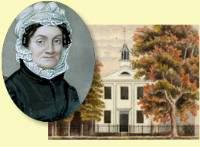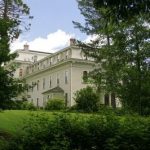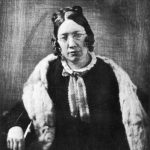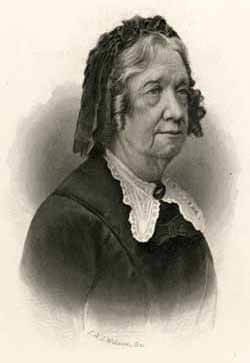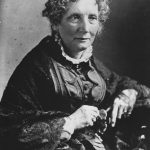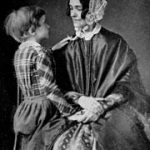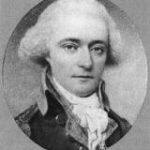Founder of Litchfield Female Academy
Sarah Pierce was the founder of one the earliest schools for girls, the Litchfield Female Academy in her home in Litchfield, Connecticut. This was one of a small group of early schools that played a critical role in shaping educational and economic opportunities for women in the United States. Through her innovative curriculum, Pierce transformed the lives of the more than 3,000 women who attended the school.
Childhood
Sarah Pierce was born June 26, 1767, the fifth child and fourth daughter of Litchfield farmer and potter John Pierce and Mary Paterson Pierce. Sarah’s mother died in 1770 and two years later her father remarried and had three more children.
During the Revolutionary War, Sarah’s brother John Pierce had a distinguished record, rising to become the Assistant Paymaster of the Continental Army, and personal friend of General George Washington. Following the close of the war, he was named Commissioner of the Army, responsible for settling the army’s debts.
Sarah’s father died in 1783, leaving her brother John Pierce responsible for his stepmother and seven younger siblings. Pierce sent Sarah and her sister Mary to New York City to be trained as teachers so they could help support their stepmother and younger half-siblings.
Litchfield Female Academy
Returning to Litchfield in 1792, Sarah Pierce established a school in her home on North Street, which became known as the Litchfield Female Academy, one of the most important institutions of female education in the United States. Some of the school’s most famous students and proteges were Catharine Beecher and Harriet Beecher Stowe.
To attract students to her school, Pierce seized upon the post-revolutionary rhetoric of Republican Motherhood, which stressed the responsibility of women to provide the early intellectual and moral training of their children. This was believed to be crucial for the survival of the new nation.
Pierce also believed in the intellectual equality of the sexes, and that increased educational opportunities for women would not jeopardize the status quo of separate spheres of activity for men and women. Pierce also upheld the idea that women’s work as mothers and in charitable and reform organizations was equally important as the work of men.
In 1792 the Litchfield Female Academy differed little from the large number of small female academies opening throughout the country, especially in the northeastern states. Pierce first offered a smattering of English, ancient and European history, geography, arithmetic and composition. But the academic curriculum developed and grew throughout the school’s forty-one year history (1792-1833).
More than 80 percent of the students were from out of town and boarded with families in Litchfield, under Sarah Pierce’s supervision. The young women were well integrated into the social, religious and cultural life of the town, known for its staunch Federalist politics and Congregational religious practice.
Prominent Litchfield residents, including the Reverend Lyman Beecher, Senator Uriah Tracy, Colonel Benjamin Tallmadge, Julius Deming and Oliver Wolcott, had family, social, political and business networks which helped attract students to Litchfield. These well-known men also gave occasional lectures to the students.
The Reverend Beecher taught religion in exchange for free tuition for his children. The leading men of the town and their wives judged the compositions, maps, art and needlework shown at the school’s annual exhibitions, adding to the school’s fame.
Sarah Pierce ran the Litchfield Female Academy efficiently, making a substantial profit while providing a means of support for many members of her family. Her sister Mary handled the boarders and the school accounts, while her sister Susan’s husband, James Brace, also taught in the school.
Pierce continuously improved and expanded her academic curriculum, offering many subjects rarely available to women, like logic, chemistry and botany. She also created her own history text, Sketches of Universal History Compiled from Several Authors, For the Use of Schools, 4 volumes. At the same time, she knew that teaching the ornamental subjects – dancing, music, foreign languages and art – was critical to the success of her school.
She experimented with innovative ways to combine the academic and ornamental subjects. Students drew and painted maps and made charts of historical events to reinforce geography and history lessons. They also illustrated poetry, literature, and mythological and Biblical readings with elaborate embroideries. Botany and natural history lessons were often illustrated with watercolor paintings.
The greatest influence Sarah Pierce had on the history of education was through the many young women she trained as teachers. More than 20 students became assistant teachers at the Academy and 58 students opened their own schools or taught in other academies, which paid far more than teaching in a common school.
She sent her nephew, John Pierce Brace, to Williams College to receive training in teaching the “higher branches” of mathematics and science. He joined the school as her assistant in 1814. Under Brace the school offered courses in Latin, Moral Philosophy, Rhetoric and Natural Philosophy, and other subjects whose suitability for women was debated well into the nineteenth century.
Pierce created an educational philosophy in which all learning – academic, moral, religious and social – was part of the total development of the young women in her school. Pierce gave frequent lectures on proper conduct in all aspects of life. Diplomas were awarded to girls completing a full course of study.
These young women were aware that they were receiving the highest level of education then available to women in the United States. The growth of the curriculum of the school also provided an important transition to the later, better-known schools for women established by Catharine Beecher and Emma Willard, both of which had their roots in the Litchfield Female Academy.
Sarah Pierce encouraged her students to become involved in benevolent and charitable societies. The Litchfield Female Academy students organized to support local missionary, Bible and tract societies and raised money for the training of ministers. Most of the students spread Pierce’s ideals of Christianity, morality, education and character to their family and friends.
The presence of Tapping Reeve’s Litchfield Law School also helped the academy to achieve a national reputation. Distant families often sent their daughters to Pierce’s Academy while their sons attended Reeve’s Law School. The presence of the two schools ensured an active social life, seen as a part of the educational training of young women. More than 100 of Sarah Pierce’s pupils married students from the Law School.
By 1798 the school became so successful that the leading men of the town took up a subscription of $385 to erect a building for Pierce’s school on the north side of her home, but left full control of the school to Pierce. The building was described as being a large room with a swinging partition in the center so that the room could be expanded or divided as needed. There was a fireplace at each end and students sat at benches with no backs during lessons.
Later Years
In 1827, when Pierce was sixty years old, a board of trustees was formed in order to finance a new larger and more modern structure on the site of the previous building, in order to attract more students. Pierce’s nephew John Pierce Brace became the director the same year, but she continued to teach, focusing on her favorite subject – history.
The effort to improve the school was not a success and John Pierce Brace left Litchfield to head Catharine Beecher’s Hartford Female Seminary in 1832. The Board attempted to keep the school going, with former students as teachers, but to no avail. The building is no longer standing today but a marker on North Street denotes where the school was located. Sarah Pierce’s house was torn down in 1896 to make way for another home.
Sarah Pierce never married; she died January 19, 1852, and was buried in the West Burying Ground.
The Litchfield Enquirer newspaper published an obituary on January 22, 1852:
We regret the necessity which compels us to announce the departure from this life of one who has perhaps been more extensively known for a period of sixty years than any other lady in New England. Miss Sarah Pierce died at her residence in this village on Monday morning, the 19th last, at the advanced age of 83 years.
The longevity of the Litchfield Female Academy, the size of the enrollments, the wide geographic distribution of the student body, the development of the curriculum and the training of teachers, all distinguish it from the numerous other female academies of the Early Republic. The young women were exposed to ideas and customs from all parts of the new nation, developing a more national perspective than most Americans of the period.
SOURCES
Wikipedia: Sarah Pierce
Litchfield Female Academy
A History of the Litchfield Female Academy
